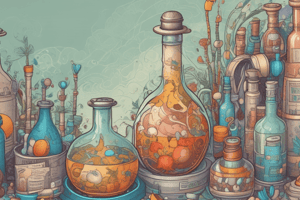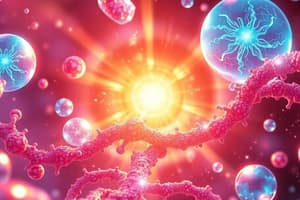Podcast
Questions and Answers
What is the term used to describe the degree to which a drug binds to its receptor?
What is the term used to describe the degree to which a drug binds to its receptor?
- Selectivity
- Potency
- Efficacy
- Affinity (correct)
What is the primary focus of pharmaceutics?
What is the primary focus of pharmaceutics?
- The production and distribution of pharmaceutical products
- The way drugs affect the body
- How drug forms influence drug effects (correct)
- The study of drug market economics
What is the effect of first-pass metabolism on drug action?
What is the effect of first-pass metabolism on drug action?
- Delays the onset of action
- Reduces drug potency (correct)
- Enhances local drug effects
- Increases systemic absorption
Which of the following organs primarily excretes drugs from the body?
Which of the following organs primarily excretes drugs from the body?
Which statement accurately describes the half-life of a drug?
Which statement accurately describes the half-life of a drug?
Which of the following best describes systemic absorption of drugs?
Which of the following best describes systemic absorption of drugs?
When is the peak level of a drug typically observed?
When is the peak level of a drug typically observed?
Which of the following is NOT a function of metabolism?
Which of the following is NOT a function of metabolism?
What does the term 'duration of action' refer to?
What does the term 'duration of action' refer to?
Which statement is true regarding the types of drug actions?
Which statement is true regarding the types of drug actions?
Flashcards
First-pass effect
First-pass effect
The process of a drug being metabolized by the liver before it reaches the systemic circulation.
Enteral route
Enteral route
Drugs administered orally go through the gastrointestinal tract, absorbed by the intestinal mucosa, then transported by the portal vein to the liver.
Protein binding
Protein binding
The process of a drug binding to albumin in the blood.
Intravenous route
Intravenous route
Signup and view all the flashcards
Intramuscular route
Intramuscular route
Signup and view all the flashcards
Topical route
Topical route
Signup and view all the flashcards
Free drug
Free drug
Signup and view all the flashcards
Drug transport
Drug transport
Signup and view all the flashcards
Metabolism (Biotransformation)
Metabolism (Biotransformation)
Signup and view all the flashcards
Excretion
Excretion
Signup and view all the flashcards
Half-life
Half-life
Signup and view all the flashcards
Onset of Action
Onset of Action
Signup and view all the flashcards
Peak Level
Peak Level
Signup and view all the flashcards
Trough Level
Trough Level
Signup and view all the flashcards
Toxicity
Toxicity
Signup and view all the flashcards
Pharmaceutics
Pharmaceutics
Signup and view all the flashcards
Duration of Action
Duration of Action
Signup and view all the flashcards
Dissolution
Dissolution
Signup and view all the flashcards
Pharmacokinetics
Pharmacokinetics
Signup and view all the flashcards
Absorption
Absorption
Signup and view all the flashcards
Bioavailability
Bioavailability
Signup and view all the flashcards
Distribution
Distribution
Signup and view all the flashcards
Albumin
Albumin
Signup and view all the flashcards
Drug-receptor action
Drug-receptor action
Signup and view all the flashcards
Affinity
Affinity
Signup and view all the flashcards
Agonist
Agonist
Signup and view all the flashcards
Antagonist
Antagonist
Signup and view all the flashcards
Enzymes
Enzymes
Signup and view all the flashcards
Selective interaction
Selective interaction
Signup and view all the flashcards
Therapeutic Index
Therapeutic Index
Signup and view all the flashcards
Tolerance
Tolerance
Signup and view all the flashcards
Dependence
Dependence
Signup and view all the flashcards
Synergistic effects
Synergistic effects
Signup and view all the flashcards
Study Notes
Pharmacological Principles Module 2
- Module 2 covers pharmacological principles, including pharmaceutics, pharmacokinetics, pharmacodynamics, pharmacogenomics, pharmacotherapeutics, pharmacognosy, pharmacoeconomics, and toxicology.
Pharmaceutics
- The study of how various drug forms influence the way the drug affects the body.
- Dissolution is the dissolving of solid dosage forms and their absorption.
Pharmacodynamics
- Drugs produce actions in various ways, depending on the cells or tissues targeted.
- Once a drug is at the site of action, it modifies cell or tissue functions (increases or decreases the rate and strength).
- Drugs cannot cause a cell or tissue to perform a function not part of its natural physiology.
- Basic mechanisms include receptor interactions, enzyme interactions, and nonselective interactions.
- Not all mechanisms of action are identified for all drugs.
Pharmacodynamics Mechanisms of Action
- Receptor Interactions:
- Drugs work by binding to a reactive site on a cell surface or inside a cell (often a protein structure).
- Affinity is the degree to which a drug attaches and binds.
- Agonists: Drugs that elicit a physiological response
- Antagonists: Drugs that block a physiological response
- Enzyme Interactions:
- Enzymes cause almost every biochemical reaction in a cell.
- Drugs can influence enzyme function by inhibiting or enhancing them (called a "selective interaction").
Drug Receptor Interactions
- Agonist: Drug binds to the receptor, causing a response.
- Partial agonist: Drug binds to the receptor, causing a diminished response compared to a full agonist.
- Antagonist: Drug binds to the receptor and prevents a response (blocks agonist binding).
- Competitive antagonist: Drug competes with an agonist for binding to the receptor.
- Non-competitive antagonist: Drug binds to a different part of the receptor, preventing activation of the receptor.
Pharmacotherapeutics
- Before initiating drug therapy, the desired outcome should be established.
- Types of therapy include:
- Acute
- Maintenance
- Supplemental (or replacement)
- Palliative
- Supportive
- Prophylactic
- Empirical
Therapeutic Index
- Ratio of the toxic level of a drug to the therapeutic level.
- Safer drugs have a larger therapeutic index.
- Drugs with a lower therapeutic index require careful monitoring.
Tolerance and Dependence
- Tolerance: decreased response to repeated doses of a drug
- Dependence: physiological or psychological need for a drug
- Physical Dependence: physiological need for a drug to avoid withdrawal.
- Psychological Dependence (Addiction): obsessive need for a drug
Drug Interactions
- Alteration of the action of one drug by another.
- Drugs may increase or decrease the actions of one or both.
- Additive effects: The combined effects of drugs with similar actions.
- Synergistic effects: One drug enhances the action of another.
- Antagonistic effects: The combined effect of drugs with opposing actions.
Pharmacogenetics and Pharmacogenomics
- Study of how genetic variations affect drug response.
- Helps understand how genetics influences different responses to medication.
- Used to personalize therapy by tailoring dosages to individual genetic profiles.
Patient-focused Considerations
- Human body changes through various life stages, affecting drug response.
- Newborns, children, and older adults have unique pharmacokinetic needs.
- Pregnant women's drug exposure affects the developing fetus.
- Breastfeeding mothers' drug exposure influences breastfed infants.
Pediatrics
- Children have thinner, more permeable skin.
- Children lack the same stomach acid to kill bacteria.
- Children's lungs have weaker mucous barriers.
- Children's bodies can have more difficulty regulating their temperature and can dehydrate easily.
- Children may have immature livers and kidneys, affecting drug metabolism.
- Dosage calculations for children need to consider weight, age, and body surface area (BSA).
Children
- Absorption in children differs from adults due to gastric pH, slower gastric emptying, decreased first-pass metabolism, and intestinal motility.
- Distribution differs between children/adults due to total body water content and protein binding.
- Metabolism is different because children have lower microsomal enzymes activity, so drug clearance can differ significantly.
- Excretion varies because of lower glomerular filtration rates and reduced tubular secretion in children.
Older Adults
- Physiological changes affect drug response in older adults, including changes in organ function, general decrease in body weight, and more or less sensitivity to certain medications.
Older Adult Changes
- Distribution is impaired due to decreased total body water and reduced protein production.
- Protein stores are decreased, so binding sites for protein-bound drugs are reduced. Consequently, there is an increase in unbound /active drug (free) drug.
- Metabolism is decreased since the liver mass losses, which impairs its function to metabolize some drugs.
- Excretion is impaired due to a decline in kidney function-resulting in reduced glomerular filtration and slower excretion.
Pharmacokinetics
- Absorption: The process of a drug entering the bloodstream from the administration site.
- Distribution: Movement of a drug throughout the body to its site of action via the bloodstream.
- Metabolism: Biochemical transformation of a drug, often by the liver, which may lead to an inactive metabolite or a more or less active one.
- Excretion: Removal of the drug and its metabolites from the body, typically the kidneys.
- Half-Life: The time it takes for the concentration of a drug in the body to decrease by half.
- Onset of Action: Time required to achieve a therapeutic effect.
- Peak Level: Highest blood concentration of the drug.
- Trough Level: Lowest blood concentration of the drug.
- Toxicity: Excessive drug concentration that causes adverse effects
- Duration of Action: Length of time the drug produces its effect.
Pharmacokinetics - Excretion
- Elimination of drugs from the body.
- The primary organ is the kidney.
- Liver and bowel metabolism can also affect excretion.
- Drugs that have been metabolized may be excreted in a less active form.
- Drugs that bypass the first-pass effect can be directly excreted by the kidneys in the original form.
Pharmacokinetics - Half-Life
- The time taken for the concentration of a drug to reduce by half.
- Used to predict the duration of drug effects and inform dosing intervals.
- Most drugs are effectively removed from the body after 5 half-lives.
Pharmacokinetics - Onset and Duration of Action
- Onset of action: The time required to elicit a therapeutic drug response.
- Duration of action: The length of time the drug produces a sufficient concentration to evoke the therapeutic response before another dose is necessary.
Pharmacokinetics - Drug Graph
- A graph depicting the drug's concentration over time, showing absorption, distribution, elimination and termination of action, peak level, trough level, and the therapeutic range showing the concentration levels.
Studying That Suits You
Use AI to generate personalized quizzes and flashcards to suit your learning preferences.
Related Documents
Description
This quiz explores critical concepts in pharmacology, focusing on pharmaceutics, pharmacokinetics, and pharmacodynamics. You will learn about how drug formulations affect body responses and the mechanisms through which drugs interact with cells and tissues. Enhance your understanding of essential pharmacological principles!




